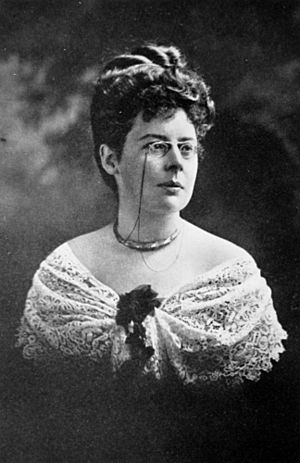Beatrice Grimshaw facts for kids
Quick facts for kids
Beatrice Grimshaw
|
|
|---|---|

Grimshaw in 1907
|
|
| Born | 3 February 1870 Dunmurry, County Antrim, Ireland |
| Died | 30 June 1953 (aged 83) Kelso, New South Wales, Australia |
| Occupation |
|
| Period | 1897–1945 |
Beatrice Ethel Grimshaw (born February 3, 1870 – died June 30, 1953) was an amazing Irish writer and traveler. She loved exploring new places. In 1903, she started writing about her travels for big newspapers like the Daily Graphic and The Times.
Her adventures led her to move to Territory of Papua, which is now part of Papua New Guinea. There, she became a close friend and unofficial helper to the leader, Lieutenant Governor Hubert Murray. Before her big travels, Beatrice was also a sports journalist and edited a magazine called the Social Review. She wrote many books, travel stories, and short stories throughout her life.
Contents
Beatrice Grimshaw's Life Story
Beatrice Grimshaw was born in a nice home called Cloona House in Dunmurry, County Antrim, Ireland. Her family was quite well-off. She was the fourth of six children.
Early Education and Interests
Beatrice studied at several schools, including Victoria College, Belfast and Bedford College, London. She never officially earned a degree. However, she was very smart and loved learning.
Beatrice was an adventurous person from a young age. She didn't want to get married or become a teacher, which was common for women back then. Instead, she chose to work for shipping companies. She even helped promote the famous Cunard Line.
She was also a huge fan of bicycling. She went on very long rides, once cycling an incredible 338 kilometers in just 24 hours!
Starting Her Writing Career
In 1891, Beatrice began her writing journey. She became a sports journalist for a magazine called Irish Cyclist. Later, she became a sub-editor there. She then took over another magazine, the Social Review, and edited it until 1903. In this magazine, she published her own poems, stories, and even novels under a different name.
Adventures in the Pacific
Beatrice always dreamed of traveling the world, especially the Pacific Ocean. In 1903, the Daily Graphic newspaper hired her to write about her travels in the Pacific. She wrote travel guides for shipping companies to encourage people to visit places like the Cook Islands, Fiji, Niue, Samoa, and Tonga.
After a short visit back home, Beatrice sailed to Papua. She was on a special assignment for The Times and the Sydney Morning Herald. She planned to stay for only a few months but ended up living there for 27 years! She became good friends with the Lieutenant-Governor, Sir Hubert Murray. The Australian government even asked her to write a special booklet called The New New Guinea to attract new settlers.
Beatrice loved adventure. She joined exploration teams deep into the jungle and traveled up big rivers like the Sepik and Fly Rivers. In 1933, she even started a tobacco farm with her brother Ramsay. After getting sick, she moved to Kelso, New South Wales in Australia in 1936 to live with her brothers.
Beatrice's Books and Stories
Beatrice Grimshaw was a very busy writer. Her stories and books appeared in many newspapers and magazines. Her books were often very popular and sold well in Australia, the United States, and England.
Her first novel, Broken Away, came out in 1897. It was about a "New Woman," which was a term for women who wanted more freedom and independence. Beatrice strongly believed in this idea.
In 1907, she published two non-fiction books about her travels: From Fiji to the Cannibal Islands and In the Strange South Seas. These books included her own photographs. That same year, she also wrote Vaiti of the Islands, a fictional story about a young, adventurous woman traveling the islands. This book showed her love for the unique landscapes of the South Pacific.
Beatrice also wrote other types of stories. She wrote mystery novels like Murder in Paradise and The Missing Blondes. She also explored supernatural themes, like witch doctors in The Sorcerer's Stone and ghosts in some of her short stories.
Film Based on Her Work
- The Adorable Outcast (1928) was a movie based on her 1922 novel called Conn of the Coral Seas.
Images for kids


